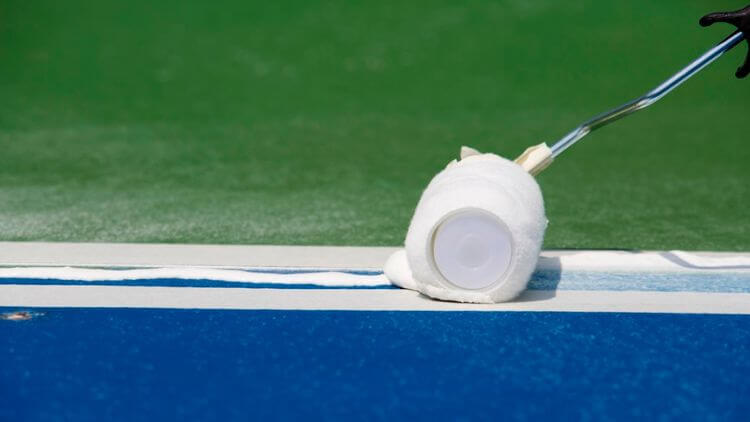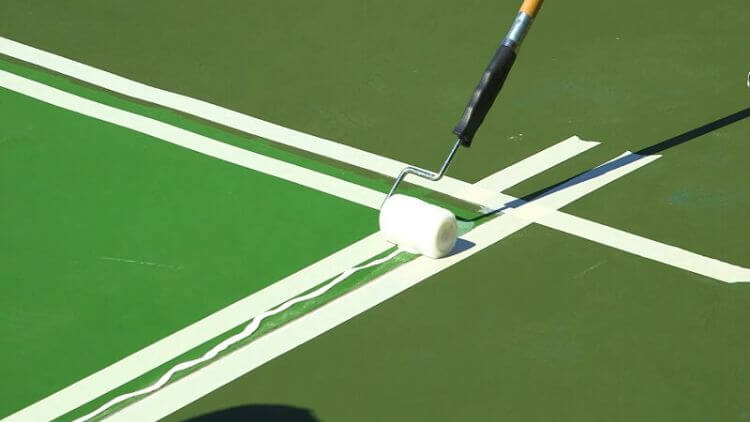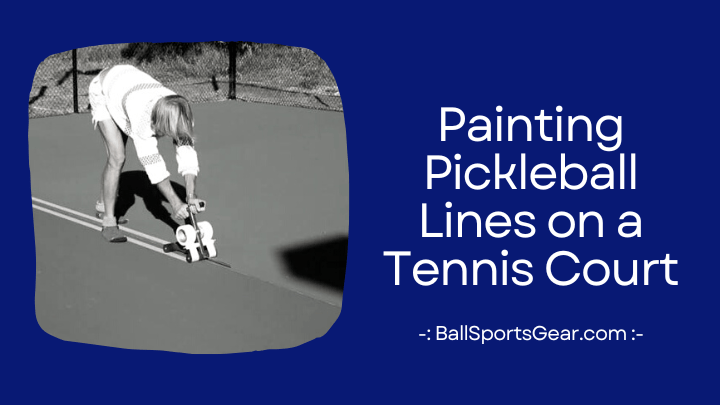Many recreational institutions regularly paint pickleball lines on tennis courts so that participants may play both games on the same court. Painting pickleball lines on a tennis court allows players the comfort of playing both games without having to transition between different courts. Pickleball, a relatively new activity, has grown in popularity over the years. Painting pickleball lines on a tennis court has been a workable option for many athletic venues in this situation.
What Are the Materials Needed to Paint Pickleball Lines on a Tennis Court
- Paint: A high-quality, durable paint that is suitable for outdoor use is what you need. For this, acrylic or latex-based paints are usually employed. Ascertain that the paint was designed specifically for surfaces like sports courts.
- Tape measure: A tape measure will be required to measure and mark the correct dimensions for the pickleball court lines. This will help ensure accuracy during the painting process.
- Chalk or marking spray: Chalk or marking spray can be used to temporarily mark the positions of the pickleball lines before painting. This allows you to make adjustments if needed before applying the permanent paint.
- Paint roller or sprayer: The paint will need to be applied to the court surface using a roller or sprayer. Depending on the size of the court and personal inclination, one should choose between a roller and a sprayer. For bigger areas, a sprayer could be more effective, but a roller offers greater control for finer lines.
- Stencils or masking tape: Stencils or masking tape can be used to create clean, straight lines. Stencils are pre-cut templates that can be placed on the court surface to guide the paint application. Alternatively, masking tape can be used to create straight edges for the lines.
- Paint trays or buckets: If you are using a roller, you will need paint trays or buckets to pour the paint into for easy access during the application process.
- Paintbrushes: Paintbrushes may be needed for touch-ups or smaller areas that are difficult to reach with a roller or sprayer.
- Drop cloths or plastic sheets: It’s essential to protect the surrounding area from paint splatters and spills. Drop cloths or plastic sheets can be used to cover the adjacent areas to prevent any accidental paint marks.
- Cleaning supplies: Have some cleaning supplies, such as water, soap, and rags or sponges, on hand to clean up any spills or drips during the painting process.
Steps to Paint Pickleball Lines on a Tennis Court
Preparing the Court Surface:
Clean the Court: Begin by thoroughly cleaning the tennis court surface to ensure proper adhesion of the paint. Sweep away any debris, dirt, or loose particles using a broom or blower. If there are any stubborn stains, you may need to power wash the surface.

Repair Any Damaged Areas: Inspect the court for any cracks, holes, or other damages. Repair these areas using appropriate materials such as crack fillers or court patching compounds. Allow sufficient time for the repairs to cure before moving on to the next step.
Measuring and Marking the Court Dimensions:
Gather the Necessary Equipment: Obtain measuring tape, a chalk line or string, and a measuring stick. These tools will help ensure accurate measurements and straight lines.
Identify the Correct Dimensions: Pickleball courts can vary slightly in size, but the standard dimensions are 20 feet wide and 44 feet long for doubles play. However, it’s always a good idea to double-check the specific dimensions required for your court.
Mark the Court Corners: Starting from one corner, use the measuring tape to measure and mark the correct distance along each side of the court. For example, if the court is 20 feet wide, measure 10 feet from the corner along one side and mark it. Repeat this process for the other side.
Connect the Marked Points: Attach a chalk line or string between the marked points on each side of the court. Stretch it taut and snap it against the surface to create a straight line. This line will serve as a guide for painting the court lines.
Painting the Lines:
Choose the Right Paint: Select a high-quality paint specifically designed for tennis courts or outdoor sports surfaces. Ensure that the paint is suitable for the type of surface you have (e.g., asphalt or concrete). Additionally, consider using contrasting colors for the pickleball lines to enhance visibility.
Start with the Baseline: Begin painting the baseline, which runs parallel to the net. Use a long-handled roller or a paint sprayer for larger areas. Apply a smooth, even coat of paint along the baseline, following the straight line created in the previous step.
Mark and Paint the Sidelines: Measure the distance from the baseline to the sideline using a measuring stick or tape. Mark these points at regular intervals along the baseline. Connect the marked points using a chalk line or string. Apply the paint along the marked lines using a roller or sprayer, ensuring clean, straight edges.
Paint the Service Boxes: Measure and mark the dimensions of the service boxes using a measuring stick or tape. Connect the marked points to create the outline of the service boxes. Apply the paint inside the outlined area, again using a roller or sprayer.
Let the Paint Dry:
Follow Manufacturer’s Instructions: Allow the paint to dry according to the manufacturer’s instructions. The drying time may vary depending on the type of paint used, temperature, and humidity levels. It is crucial to give the paint sufficient time to cure and harden before allowing any foot traffic on the court.
Ensure Proper Ventilation: During the drying process, ensure adequate ventilation to allow the paint fumes to dissipate. This is especially important if you are painting indoors or in an enclosed space.
Avoid Disturbing the Paint: Prevent any foot traffic, objects, or debris from coming into contact with the freshly painted lines until the paint has completely dried. This will help preserve the quality and integrity of the lines.
Tips for Painting Pickleball Lines on a Tennis Court
Usage a premium exterior paint that is made for outdoor usage.
Painting pickleball lines on a tennis court requires careful consideration when choosing the type of paint to use. Look for a premium paint that is primarily designed for outdoor use to ensure that the lines are durable and strong. Pick a paint that is fade- and weather-resistant as the lines will be exposed to the elements.

Apply the paint in thin, even coats.
Apply the paint in thin, even applications when painting pickleball lines on a tennis court. This will guarantee that the paint doesn’t get too thick or clumpy and that the lines are tidy and straight. You might wish to use a stencil or tape to outline the lines before painting them in order to give them a neat and polished appearance.
Allow the paint to dry completely before playing on the court.
Once you’ve painted the pickleball lines on the tennis court, it’s important to allow the paint to dry completely before playing on the court. This will ensure that the paint is fully cured and won’t smudge or smear when players run over it. Depending on the type of paint you use and the weather conditions, you may need to wait several days or even a week before playing on the court.
Frequently Asked Questions
A: The frequency of repainting pickleball lines on a tennis court depends on factors such as usage, climate conditions, and the quality of the paint. Generally, lines may need to be repainted every 1-2 years to maintain their visibility and integrity.
A: Yes, you can hire professional court resurfacing or painting companies who have experience in painting pickleball lines on tennis courts. They have the expertise and specialized equipment to ensure accurate and durable line markings.
A: Yes, pickleball lines can be removed from a tennis court. The process typically involves using a paint stripper or a specialized line remover to erase the lines. It’s recommended to consult professionals to ensure the court surface is not damaged during the removal process.
Conclusion
In conclusion, painting pickleball lines on a tennis court is a useful way to utilize the court space and cater to the increasing demand for both sports. It not only saves space and resources but also allows players to enjoy the benefits of playing two sports on a single court. With the increasing popularity of pickleball, more and more sporting facilities are adopting this approach to meet the needs of their players. Overall, painting pickleball lines on a tennis court is a practical and cost-effective solution that benefits both players and facility owners alike.

